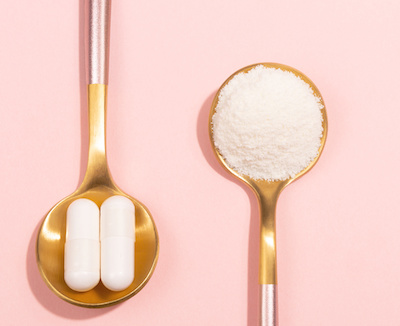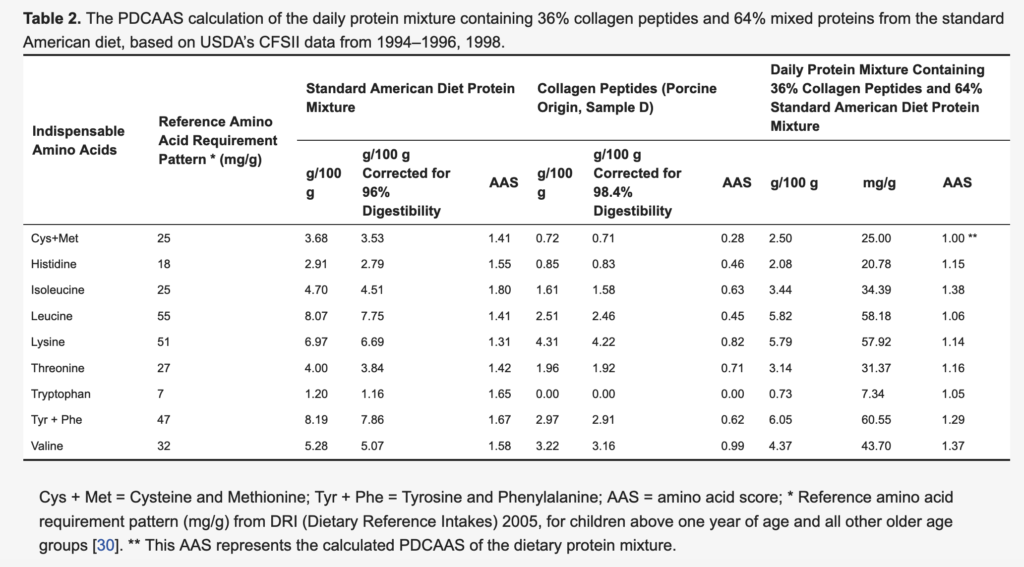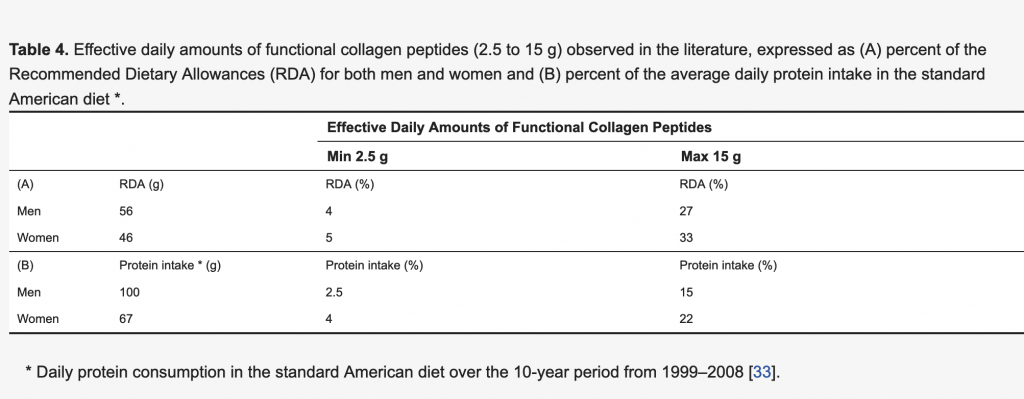In recent years, collagen has become the go-to dietary supplement for morning smoothies and coffee as well as afternoon  energy drinks for adults of all ages and fitness levels. Collagen peptides are well-established as a source of functional peptides with biological activity, such as improving skin elasticity, recovering lost cartilage tissue, lowering activity related joint pain, strengthening tendons and ligaments and increased lean body mass in elderly men and pre-menopausal women. One of the issues often discussed is that a high level of collagen in the diet could lead to a low Protein Digestibility-corrected Amino Acid Score (PDCAAS), mainly because of the complete absence of the indispensable amino acid tryptophan.
energy drinks for adults of all ages and fitness levels. Collagen peptides are well-established as a source of functional peptides with biological activity, such as improving skin elasticity, recovering lost cartilage tissue, lowering activity related joint pain, strengthening tendons and ligaments and increased lean body mass in elderly men and pre-menopausal women. One of the issues often discussed is that a high level of collagen in the diet could lead to a low Protein Digestibility-corrected Amino Acid Score (PDCAAS), mainly because of the complete absence of the indispensable amino acid tryptophan.
A majority of studies have looked at supplementation with doses of 2.5 to 15 g of bioactive collagen peptides over periods of three to 18 months. A study published in the journal Nutrients determined the maximum level of dietary collagen peptides that can be added to a Western diet while maintaining its indispensable (essential) amino acid balance (read more on this here).
ABSTRACT / According to the current protein quality evaluation method PDCAAS, collagen protein lacks one indispensable amino acid (tryptophan) and is therefore categorized as an incomplete protein source. Collagen protein displays a low indispensable (essential) amino acid profile, yet as a functional food, collagen is a source of physiologically active peptides and conditionally indispensable amino acids that have the potential to optimize health and address physiological needs posed by aging and exercise. As stated, this study was determined the maximum level of dietary collagen peptides that can be incorporated in the Western pattern diet while maintaining its indispensable amino acid balance.
This study used PDCAAS-based protein quality scores to adjust dietary protein intakes to meet the daily requirements of indispensable amino acids. Ideally, the amino acid scores (AAS) of a protein or protein mixture should not exceed 1.0, i.e., fulfill 100% of the indispensable amino acid requirements while minimizing excess because the body’s metabolic needs include both indispensable and dispensable amino acids. As a consequence, if one or more of the indispensable amino acids are present in excess of requirements, the diet becomes limited in dispensable amino acids, thus unbalanced, even though the PDCAAS remains equal to 1.0.
On the basis of these observations, incorporating functional collagen peptides in the diet without compromising on the indispensable amino acid adequacy can add the nutritional value of dispensable amino acids. The objective of this study was to determine the maximum level at which collagen peptides may be incorporated into the typical protein mixture of the standard American diet without lowering the overall PDCAAS score below 1.0.
The amino acid composition of the collagen peptides was selected from publicly available data on six commonly consumed dietary sources of collagen peptides—four samples from porcine, one sample from bovine (GELITA AG, Eberbach, Germany), and one sample from marine origins. The four hydrolysates from porcine collagen were produced using different protease treatments.
Study results:
- The PDCAAS calculations determined that a level as high as 36% of collagen peptides may be used as protein substitution while maintaining the indispensable amino acid balance and the high protein quality score of the standard American diet (PDCAAS equals to 1.0). See FIGURE 1.
- In this study, the individual amino acid scores of the standard American diet ranged from 1.31 to 1.67 (See TABLE 2), indicating an indispensable amino acid surplus of 31% to 67% that allowed for the 36% substitution with collagen peptides, while maintaining the PDCAAS of the diet equal to 1.0.
- When compared to both the minimum RDAs and the actual dietary protein intakes for both men and women in absolute values, the effective daily amounts of functional collagen peptides (2.5 to 15 g) observed in the literature were found to be below the maximum level of collagen that may be incorporated in the standard American diet. See TABLE 4 below.
FIGURE 1

TABLE 2
TABLE 4
Research shows that bioactive collagen peptides upregulate the synthesis of extracellular matrix proteins in various tissues via a stimulatory cell effect, which provides the specific amino acid building blocks for body collagens. The evidence suggests that by incorporating the functional components of collagen in the daily diet, it enhances whole body collagen turnover and other aspects of health more effectively than the current standard mix of proteins in common Western diets. “Despite the low indispensable to dispensable amino acid ratio in collagen protein, the Western pattern diet usually contains a significantly high amount of indispensable amino acids, due to high intakes of protein derived from animal food sources,” the researchers wrote.
This study evaluated whether the concern with high levels of collagen protein in the diet could lead to a low PDCAAS, mainly because of the complete absence of the indispensable amino acid tryptophan. “However, since collagen protein is not consumed as the sole or primary source of protein, its nutritional contribution must always be evaluated in the context of a mixed protein diet.” And, since the adult diet contains a variety of protein sources, the use in isolation of the PDCAAS value of collagen is of no practical significance. “This study shows that even though collagen peptides do not contain tryptophan and are low in cysteine and methionine, the average US diet contains a surplus of these amino acids that allows for the substitution of the total protein intake with 36% to 54% collagen peptides, while maintaining a “good” or “high” dietary protein quality (PDCAAS equals 0.75–1.0). An additional benefit of this substitution may be derived from the increased dietary content of glycine, proline and hydroxyproline, all major components of body collagens, which in turn represent 25–30% of total body proteins.”
CONCLUSION / “It is beneficial to include functional collagen peptides as part of the daily protein intake, not only for their bioactive properties but also for their rich availability of conditionally indispensable amino acids that may become indispensable under specific physiological situations and life stages. The recommended amount of collagen peptide intake may vary according to the specificity of the peptide (bioactive or non-bioactive), and to the desired health benefit (e.g., skin and nail health, joint health or muscle and bone health). The effective amounts of functional collagen peptides observed in the literature suggest intakes in the range of 2.5 to 15 g daily. These amounts are below the 36% proportion of collagen determined in this study as an adequate substitution in a high-quality protein diet, so that functional collagen peptides may be incorporated in the standard American diet while maintaining indispensable amino acid balance.”







